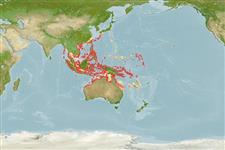>
Eupercaria/misc (Various families in series Eupercaria) >
Nemipteridae (Threadfin breams, Whiptail breams)
Etymology: Pentapodus: Greek, pente = five + Greek, pous = feet (Ref. 45335).
More on author: Cuvier.
Environment: milieu / climate zone / depth range / distribution range
Ökologie
seewasser riff-verbunden; tiefenbereich 2 - 35 m (Ref. 90102). Tropical; 33°N - 24°S, 93°E - 175°E (Ref. 3810)
Western Pacific: southern South China Sea and the eastern Malay Peninsula to the Gilbert Islands, north to the Ryukyu Islands, south to Timor and New Caledonia (Ref. 37816). The name Pentapodus caninus has been misapplied to Pentapodus trivittatus.
Size / Gewicht / Alter
Maturity: Lm ? range ? - ? cm
Max length : 35.0 cm TL Männchen/unbestimmt; (Ref. 9710); common length : 15.0 cm SL Männchen/unbestimmt; (Ref. 3810)
Rückenflossenstacheln (insgesamt): 10; Rückenflossenweichstrahlen (insgesamt): 9; Afterflossenstacheln 3; Afterflossenweichstrahlen: 7. Head scales reaching forward to or just in front of level of anterior nostrils. Scaled area between nostrils with a distinct naked medial wedge-shaped notch. Suborbital scaly posteriorly. Lower limb of preopercle with 2 or 3 scale rows. Pelvic fins moderately long, reaching to or almost to level of anus. Upper lobe of caudal fin slightly longer than lower. Axillary scale present. Color: Upper body pale blue, lower whitish.
Usually found close to the bottom over coral reef areas. Feeds on small fishes and larger zooplankton, as well as on benthic organisms (Ref. 9785). Occurs solitary or in small groups.
Life cycle and mating behavior
Geschlechtsreife | Fortpflanzung | Ablaichen | Eier | Fecundity | Larven
Russell, B.C., 1990. FAO Species Catalogue. Vol. 12. Nemipterid fishes of the world. (Threadfin breams, whiptail breams, monocle breams, dwarf monocle breams, and coral breams). Family Nemipteridae. An annotated and illustrated catalogue of nemipterid species known to date. FAO Fish. Synop. 125(12):149p. Rome: FAO. (Ref. 3810)
IUCN Rote Liste Status (Ref. 130435)
Bedrohung für Menschen
Harmless
Nutzung durch Menschen
Fischereien: kleinfischerei
Mehr Information
NamenSynonymeMetabolismusRäuberÖkotoxikologieFortpflanzungGeschlechtsreifeAblaichenSpawning aggregationFecundityEierEientwicklung
ReferenzenAquakulturAquakultur ProfilZuchtlinienGenetikElectrophoresesVererbbarkeitKrankheitenVerarbeitungNutrientsMass conversion
Tools
Zusatzinformationen
Download XML
Internet Quellen
Estimates based on models
Preferred temperature (Ref.
123201): 26.4 - 29.3, mean 28.7 °C (based on 1974 cells).
Phylogenetic diversity index (Ref.
82804): PD
50 = 0.5002 [Uniqueness, from 0.5 = low to 2.0 = high].
Bayesian length-weight: a=0.01820 (0.01098 - 0.03017), b=2.94 (2.80 - 3.08), in cm total length, based on LWR estimates for this species & (Sub)family-body (Ref.
93245).
Trophic level (Ref.
69278): 3.6 ±0.49 se; based on food items.
Widerstandsfähigkeit (Ref.
120179): mittel, Verdopplung der Population dauert 1,4 - 4,4 Jahre. (Preliminary K or Fecundity.).
Fishing Vulnerability (Ref.
59153): Low vulnerability (25 of 100).
Nutrients (Ref.
124155): Calcium = 51 [32, 107] mg/100g; Iron = 0.707 [0.350, 1.491] mg/100g; Protein = 18.9 [17.0, 20.6] %; Omega3 = 0.138 [0.081, 0.239] g/100g; Selenium = 28.3 [16.3, 52.6] μg/100g; VitaminA = 109 [30, 319] μg/100g; Zinc = 1.12 [0.76, 1.60] mg/100g (wet weight);
